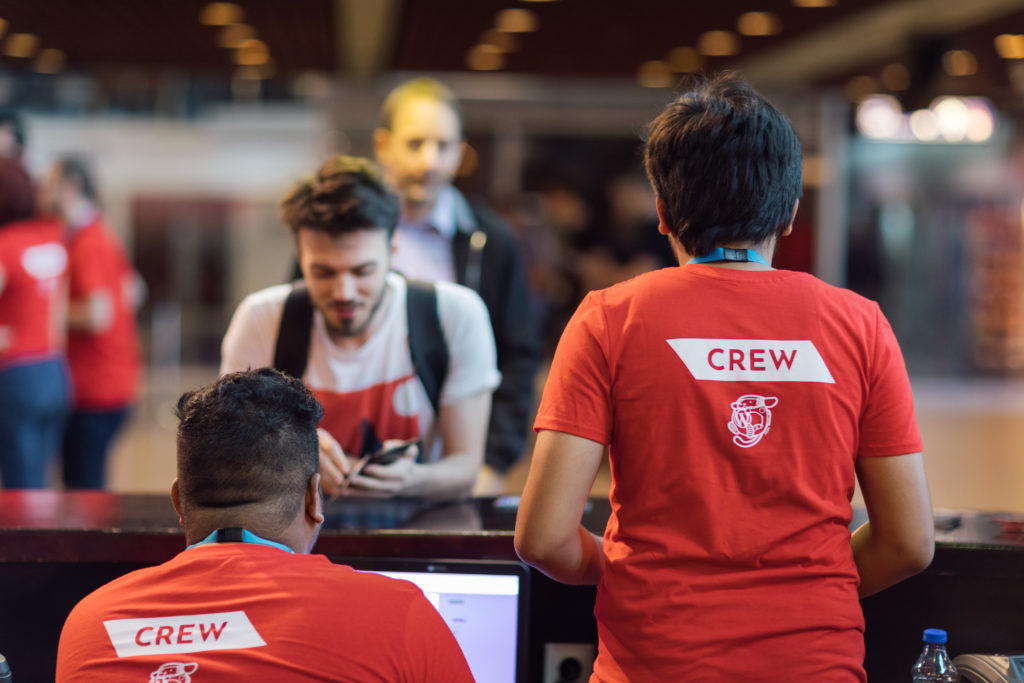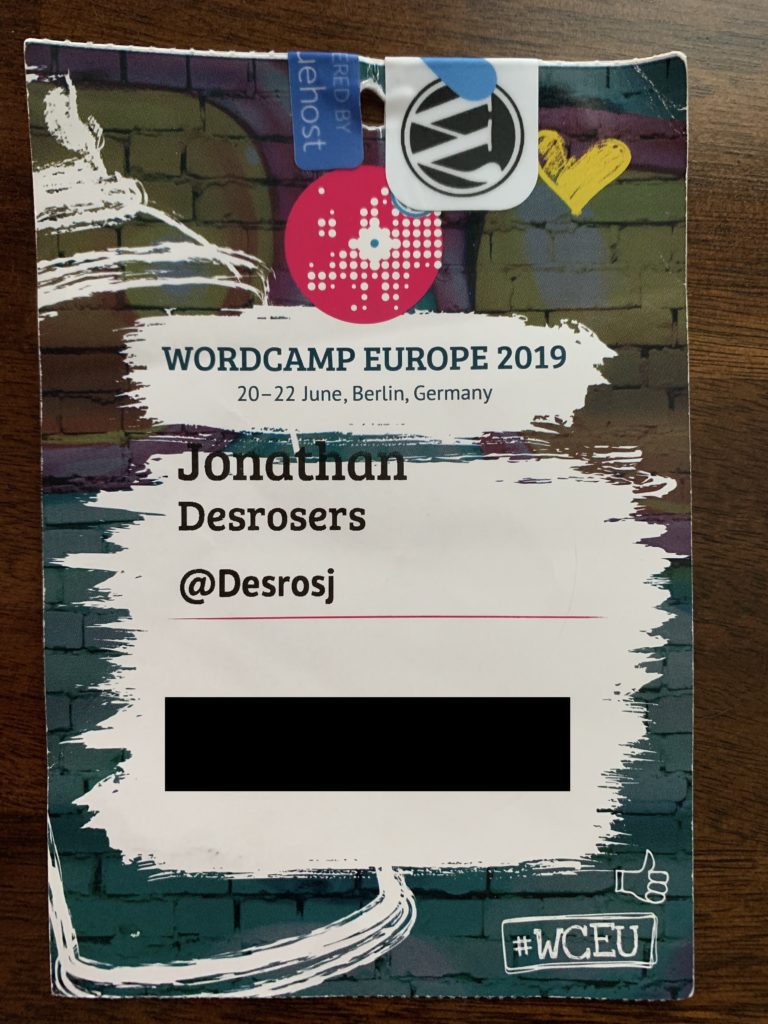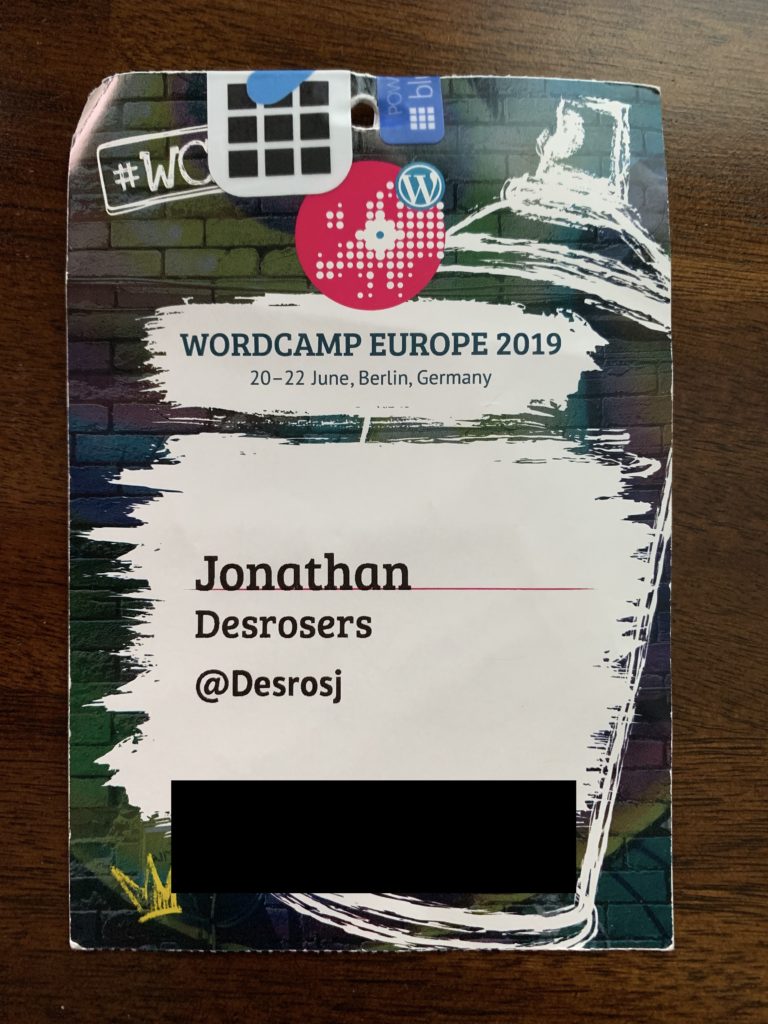Last week at WordCamp Europe, I found myself thinking about what makes a good conference badge. I thought I’d collect my thoughts for the purpose of feedback and to see if others felt the same way.
Note: planning conferences is hard. I applaud the WordCamp Europe team for trying something new with their badges. But, there were some things missing from this year’s badges that I realized were important to me. I wanted to detail what they are and why they are important to me.
WordCamp Europe 2019 Badges
If you were fortunate enough to attend WordCamp Europe this year, here is what your badge would have looked like:
Here’s a breakdown of what I liked and what I did not like about the badges.

Pro: Less Wasted Material
This year, the badges were printed at the registration table as you checked in. It’s not uncommon for 10-20% of registrants to no-show because of the low cost of WordCamps. At WordCamp Europe, over 2,700 registered attendees out of over 3,200 total tickets sold attended (around 84%). The event was able to avoid wasting the material for 500 badges by not printing badges ahead of time.

Pro: Less Volunteer Time
Because badges were not printed ahead of time, there was no need for volunteers to spend time alphabetizing and organizing the badges. The time spent manually going through badges looking for a specific attendee’s badge when checking in was also eliminated.

Pro: Easier Check In
Because the badges were printed on demand, there was no need to create lines based on letter ranges (A-D, E-H, etc.). This is often hard to accomplish because the signs for each line are usually on the table itself, which is hard to see from the back of the line. Instead, attendees could hop into any line and get checked in.

Pro: Twitter Account
Besides trading business cards or emails, Twitter handles are, in my opinion, the easiest way to connect with a person to continue conversations after a conference. When this is included on a badge, it’s easy to follow them in the moment, or to take a photo of their badge to follow up later.

Con: Durability
Unfortunately, my badge ripped halfway through Contributor Day. I was able to perform minor surgery with some stickers to reinforce the hole, but this is an issue I always seem to encounter with paper badges.
I have included a photo of my WordCamp US 2018 badge. This badge was made of plastic and held up great to the 3 day conference. I realize that plastic is not the most sustainable material, so I am not advocating for plastic badges. But this type of badge is much more durable.

Con: Mysterious Barcode
The black box on my badge is covering a barcode that was printed on everyone’s badge. It still is not clear to me what the purpose of the barcode was or what information was attached to it. The only time my barcode was scanned was when I visited a few sponsor booths. But, even then, the explanations were different and unclear.
One sponsor asked to scan my badge so that “they knew who had come by to visit” and another said that scanning my badge allowed them to “reach out to me after the conference.” If the barcode gave sponsors access to any personal information (such as email), I would have liked that to be more clear. I would not have allowed them to scan my badge if the intention was to add me to a newsletter or marketing list.
I am not opposed to barcodes on badges (I think this could be really useful for checking into different conference related events or claiming t-shirts, etc.), but they should not provide access to personal information.
Con: Misprint
The printing on my badge was a bit off. On one side, my name was printed a bit too high which made it hard to read. On the other side, the barcode was printed off the white part. If the barcode were more important, this could have caused me problems. I also misspelled my name when I registered. This was totally my fault, but it got me thinking about ways attendees could confirm their information before finalizing.

Con: No Avatars
This is a huge one for me. I am a very visual person. I spend countless hours interacting with people on Slack, Trac, Twitter, etc. Many times when I start talking to someone at a conference it is hard to connect the dots of who person is. But, when avatars are on badges, I almost instantly realize who they are and make a mental connection to past conversations because an avatar is something I am already very familiar with.
Con: No Companies
The badges also did not have a company listed. I often find this useful for starting conversations. Sometimes this information combined with an avatar also helps me make a mental connection to a person.
Summary
In summary, here are the badge elements that are most important to me in no particular order.
- Name
- Avatar
- Durability
- Company
- Twitter handle
- No sensitive personal information (like email), or a way for sponsors to access that.
What badge elements are important to you and why? Do you have an all time favorite badge design? Share below!
Photo credits: Bas Emmen, Jon Tyson, Sara Kurfeß, and Kevin Jesus Horacio on Unsplash. WordCamp Europe 2019 press kit.


12 responses to “What Makes A Good Conference Badge?”
I agree twitter handles and avatars are nice.
Adding an affiliated company would be good too, but most employees of companies are probably wearing a company shirt or something, so it will often be redundant.
Here’s one idea I had in order to encourage event sponsors: based on the sponsor’s contribution and the number of attendees that paid for, put a sponsors logo on the badge. Eg if each attendee costs $50, and BlueHost contributed $5000 to the event, 100 badges would say “BlueHost paid for my ticket!”. Likewise with other sponsors.
The point is to create a direct connection between attendees and sponsors, rather than just “blue host paid for some chunk of the event”, and to give attendees a better idea of how much each sponsor contributed. I would think this would encourage more sponsorship.
I agree that this is usually the case for sponsors with booths, but far less common for general attendees. Badges are usually required at after parties and conference related events, and many sponsors change into more casual attire for these, removing the obvious affiliation.
I don’t think that is a bad idea to encourage more sponsorship. Personally though, I would much rather we move towards a reusable badge designed for use at ANY WordCamp. So having a sponsor on the badge would complicate that, as they may not sponsor every camp, or may stop sponsoring camps and move out of the space in the future.
Both good points. Ya having reusable badges would be good too (especially for environmental reasons?)
Great thoughts Jon. I was also concerned about the barcode so I scribbled on top of it. It wasn’t required for the after party or anything other than a couple of sponsors that asked me to scan it–and were surprised to find out I rendered it useless–so I wonder what kind of info was exposed in it. I think there should have more transparency about it.
Someone had the answer for this on Twitter: https://wptavern.com/wordcamp-europe-introduces-official-mobile-app-new-tech-for-on-site-badge-printing
I have two emails, one that I use for communicating with people/important things and check far more often, and one I use to sign up for newsletters and accounts and check less often. For WordCamps, I typically use my priority inbox so that I don’t miss emails with information about the event.
I would be 100% OK with the barcode if
A) I knew ahead of time what it was.
B) Could set a different email to connect to the barcode.
C) Could elect not to link an email to the barcode.
In my opinion, the third one is important because it eliminates the pressure to say OK you can scan my badge if you really don’t want them to. You can let them scan your badge and know that your information will not be handed over to the sponsor.
Adding the company is a really good idea I think.
The avatar would be also great to have. But I’m concerned about it needing color printers at registration and I don’t know how feasible or expensive that might be: is it worth it? There is wifi at all these events, one can quickly search for the handle and immediately make the connection too.
But most of all PLEASE don’t make plastic look like a good alternative. Plastic is not only “not the most sustainable material” is one of the worse causes of pollution in our oceans!
For something as temporary as a badge for a few days, I think no one should EVER make plastic badges!
The durability of paper badges is an issue, I understand but there are stickers in circle Form that as precisely for this purpose and once a badge breaks, attendees can easily go to registration to fix their badge.
Mine did not rip until late into the after-party, so it does not happen all the time so soon, so I think going for stickers when it rips is way more environmentally friendly than making them all in plastic from the get go.
Those circle hole punch reinforcers came to mind as well. There are also metal grommets that could probably be used too.
Making plastic look like a good alternative was definitely not my intention here. 🙂 I just wanted to show that there are more durable alternatives to investigate.
Unfortunately that’s not really a positive in this case (er, less material certainly is..) I question how many were preprinted.. Only the name/twitter/barcode were printed on the day, that means the rest of the tag had to be preprinted, which requires that they’ve got at least 3,200 ready, and to account for reprints/etc you’d have to have at least 4,000 or more on hand. Hopefully the blanks were properly recycled.
Due to the printing style, it also uses twice the paper as it’s single sided printing (so at least 6,400 badge pieces, I’ll let you decide what the minimum print run would be) – at least the badges are a lower gsm paper (they feel like a coated 150gsm?).
To combat the plastic waste, in the past I’ve made wordcamp badges that were devoid of wordcamp branding so they could be reused – I used one of mine at wceu attached in front of it for example (which had my avatar, etc).
Unfortunately as with all reusable things, I’m never quite sure how many people reuse them, much like all of the badge lanyards that get given out at WordCamps never to see the light of day again.
Ah, that’s a good point about needing to have enough printed branded badges without names. So it’s likely that the ink for printing ~500 names/barcodes on the badges was saved, but less the paper.
I like the idea of a “general WordCamp” badge. There can always be areas to place stickers on the badge for specific event branded stickers like many people do with their laptop. Have you ever had an event say you had to use their branded badge?
Avatar: not easy to print the badge on check-in and having it print the avatar as well (you need a color printer for that, I guess, and previous avatar retrieval). This would probably work if the badges are pre-printed, as usual in a lot of WordCamps.
Plastic: please no. I’ve never damaged a paper badge before. Won’t say it doesn’t happen, of course it does. I would prefer one could ask for a reprint than have plastic badges.
I think I prefer the badge having extra info. On the other hand, having the name on both sides of the badge makes it always visible, which is good.
One thing I disliked during WCEU is the pocket programme. Not very practical. The leaflet, IMO, was excessive and unnecessary. Probably a booklet would’ve worked better.
I definitely agree with this. I loved the leaflet itself (design, usefulness, etc.). But having it tucked away in that flap was a little bit of a pain.
Hi Jonathan, thanks a lot for this article. I hope to find more of these Pro and Con so we can tune WCEU accordingly next time.